Cut Protection & Its Importance:
Cut resistance refers to a user's way of avoiding scratches, minor cuts, and other hand injuries that come with prolonged contact with sharp equipment. Cut-resistant gloves should be worn to reduce the risk of being cut to a specific degree. No glove can completely protect you from getting cut, you can decrease your chances of being cut significantly. Employees in industries that require them to work with bottles, metalworking, or other sharp-edged materials are especially vulnerable. In the butcher industry, knife cuts and injuries are widespread, so if you work as a butcher and frequently handle knives, you're in danger.
NMSafety is now one of the top cut-resistant glove manufacturers, with cut protection that is much superior to the competitors.
Cut Resistant 5/A3/C Foam Nitrile Coated Gloves:
It preserves the user's fingertips and hands against cuts that are prevalent in industries such as manufacturing, handling, and car maintenance. On a tiny scale, that is. These gloves have the best grip among all since they are made of sandy nitrile, which is oil-proof and perfect for wet environments.
Benefits Of Using These Cut Resistant 5/A3/C Foam Nitrile Coated Gloves:
Here are some types of resistance that you can get using these gloves.
Water Resistance:
Foam nitrile is waterproof, mechanical fluid-resistant, and oil-resistant, and can withstand a wide range of goods, liquids, and chemicals. The nitrile shields the wearer's hands from germs and prevents them from damaging whatever they touch.
Oil Resistance:
The major purpose of nitrile-coated cut gloves is to offer technical workers the best grip possible. Elevating greasy materials is a regular part of the job, so their hands are protected with an outer layer so they can maintain a tight grip on the items they're handling.
Hand Safety against Oil:
These are commonly used throughout the automotive market and are built to withstand the amount of work that these people do. Therefore these gloves will keep your hands clean and safe from oil pollution.
Wound Protection:
These ensure that the protection against cuts, bruises, puncture wounds, and other damages they provide will not affect you at employment. Working with catheter instruments and glass walls necessitates the use of anti-cut gloves. These can save your life by keeping you out of dangerous circumstances. It can be damaging to one's health if broken glass is contaminated with toxic chemicals, fluids, or infectious substances that penetrate the skin through a cut or puncture.
Characteristics Of These Cut Resistant 5/A3/C Sandy Nitrile Coated Gloves:
A3 ANSI Cut Level: A3 is a moderate threat mitigation cut level (1000-1499 grams to cut).
Nylon & HPPE Knitted Liner With Glass Fiber Knitted Liner: HPPE produces a lighter, more ventilated, more versatile glove that also helps to avoid cuts and tears. While the nylon and fiberglass in the lining composition are unaffected by humidity, Nitrex 244 is ideal for food preparation, manufacturing, and packing.
13-Gauge Thickness: Gloves with a gauge of 13 and higher are considered very dexterous, as the gauge thickness increases, the glove becomes thinner. We've placed them together because the thread thickness is less noticeable in this category. Gloves with a gauge of 13 or higher are considered highly dexterous, because the higher the gauge, the thinner the glove.
Foam nitrile Coating: Foam nitrile is well-known for its excellent slip resistance. In contrast to all other nitrile coatings, it is also more stretchy and contour-fitted. It's great in sticky conditions and even better in damp areas.
Look For Certain Things To Find The Best Anti Cut Glove:
Cut Level:
If your job requires protection from flames, scrapes, fluids, and other hazards, the cut level is an important consideration when purchasing gloves.
Prefer Foam Nitrile Coatings For Dexterity And Longevity:
Specific material handling jobs frequently necessitate coated materials, which make gloves an ideal PPE tool. In this regard, foam nitrile is anti-slip and boosts glove durability by 10 times over uncoated gloves, allowing you to complete your tasks accurately.
Fitting:
Your PPE should fit rightly according to the contour of your hand. The anti-cut gloves should be made of flexible material to make them adjustable enough that they should adopt the exact shape of your hand.
Anti-Slip Grip:
To make them oil-proof, their palms are coated with sandy nitrile which makes them perfect to get protection against abrasions while improving their durability, longevity, and grip.
Some Exceptional Cut Resistant Gloves:
Impact Resistant & Cut Resistant Gloves:
These gloves are made up of knitted liner containing 18 gauge nylon HPPE and steel fiber as it is the right material that someone is needed while performing lighter-heavy work. Though they are not heavy-duty gloves they have a lightweight TRP padding on their back that helps the users to perform the work without feeling any load while keeping them safe from pinch or bruises to lacerations hazards.
Cut Resistant 5/A4/D Latex Coated Gloves:
These gloves ideally protect against cuts, infections, and chemicals that may be a high point of concern for people that are working in a warehouse, dealing with logistics, construction, or any other. Regardless of the industry, you can use them if grip, contamination, cuts, and chemicals are your concerns. Not only that, they will help you multitask.
Summary:
Hand Protection measures should be in place, particularly when confronted with conditions that could result in cuts, bruises, burns, or punctures. Consider wearing this PPE a regular part of your workday. Even though they're a good pick, some users will dislike them. Cut-resistant gloves can be purchased from a reputable provider at any time. We recommend that you shop at NMSafety since their products are of exceptional quality.









